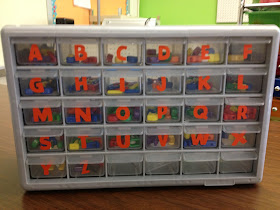What little one doesn’t love beads? Really! They're colorful, they come in different shapes and sizes, and they literally can hold a kiddo's attention forever! I don't think that fascination for beads goes away for a long time.
In my own house of three boys, this is the collection of the bead activities that have been completed just
in the last two weeks and they are 5, 7 and 9.
Don't get me wrong. I love the idea of just PLAYING with beads, but if beads can motivate or engage a child to learn something they might otherwise find mundane, shouldn't we give it a try? That's what I was thinking when I started using beads to differentiate my instruction.
Not only do beads provide fabulous fine
motor practice for little fingers, but you can use them for counting and
sorting and making patterns . . . and they're fun! So several years ago, I thought, if kinders like beads so much, how can I use them better and more effectively in my classroom. Little did I know they would end up being one of my favorite tools for differentiating activities.
Of course I'm going to give you a little review. When we differentiate, we do so in response to: interest, learning style or readiness.
So beads can provide an engaging activity for students who might not otherwise be interested in spelling or word work. Beads are appealing to students who are spatial and kinesthetic learners , who like to work with their hands and prefer to move.
And finally, we can offer students activities based on their readiness levels by working with beads... It's true... and I'll show you how I do it.
I think the majority of everyone has letter beads of some kind or flavor laying around their room somewhere. It doesn't matter really what kind you have. Some are the small square kind with a letter stamped on them while others are shaped like the letter itself.
I personally prefer the shaped kind and have become quite a collector.
Here's why I love them so. In my kindergarten classroom, letter beads can be used from the first day of class with activities like sorting...
to the last day of class with students using them to write digraphs.
In the beginning when I'm setting up my bead station, its mostly about those early activities that encourage exploring and building good routines and procedures with the beads.
We sort by letters in our name.
We sort by capitals and lowercase letters.
We match up letters.
And we use a ABC chart to match up letters and sounds (click on the picture to get a copy of your own).
These are very basic activities that will allow your students to practice the expectations of your bead station and the routines for taking care of it.
You'll want to set up a way to organize your beads. I have used both a small portable plastic divided container
and a more stationary container will pull out drawers.
I honestly prefer the smaller plastic containers, because they are very mobile and students can basically pick up an activity and move to any space in the room that is available for them to work. They quickly set up their cookie sheet and playing cards and are ready to go in seconds.
The beauty of beads for differentiating, is that I can have several students using them at the same time, but they can be doing very different activities that at their readiness level. While some students might be working on a CVC production activity another student can be working on a digraph activity like the one above.
Providing 'I Can...' sheets and self-correcting playing cards, make it an incredibly independent station for my kinders.
So if you're looking for new ways to engage students, consider the power of the differentiating bead!
If you'd would like to see other ways that beads are used in my classroom, please stop on over to A Differentiated Kindergarten.
And stop over and grab your own free Bead Starter Kit.







































